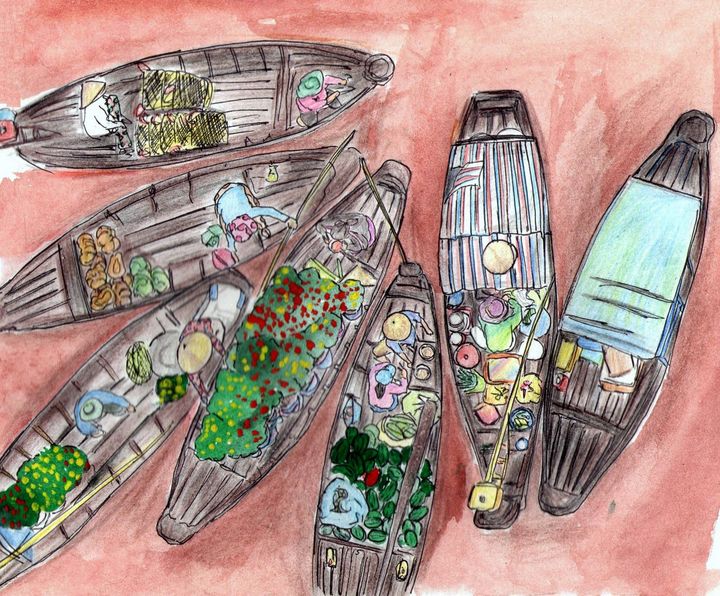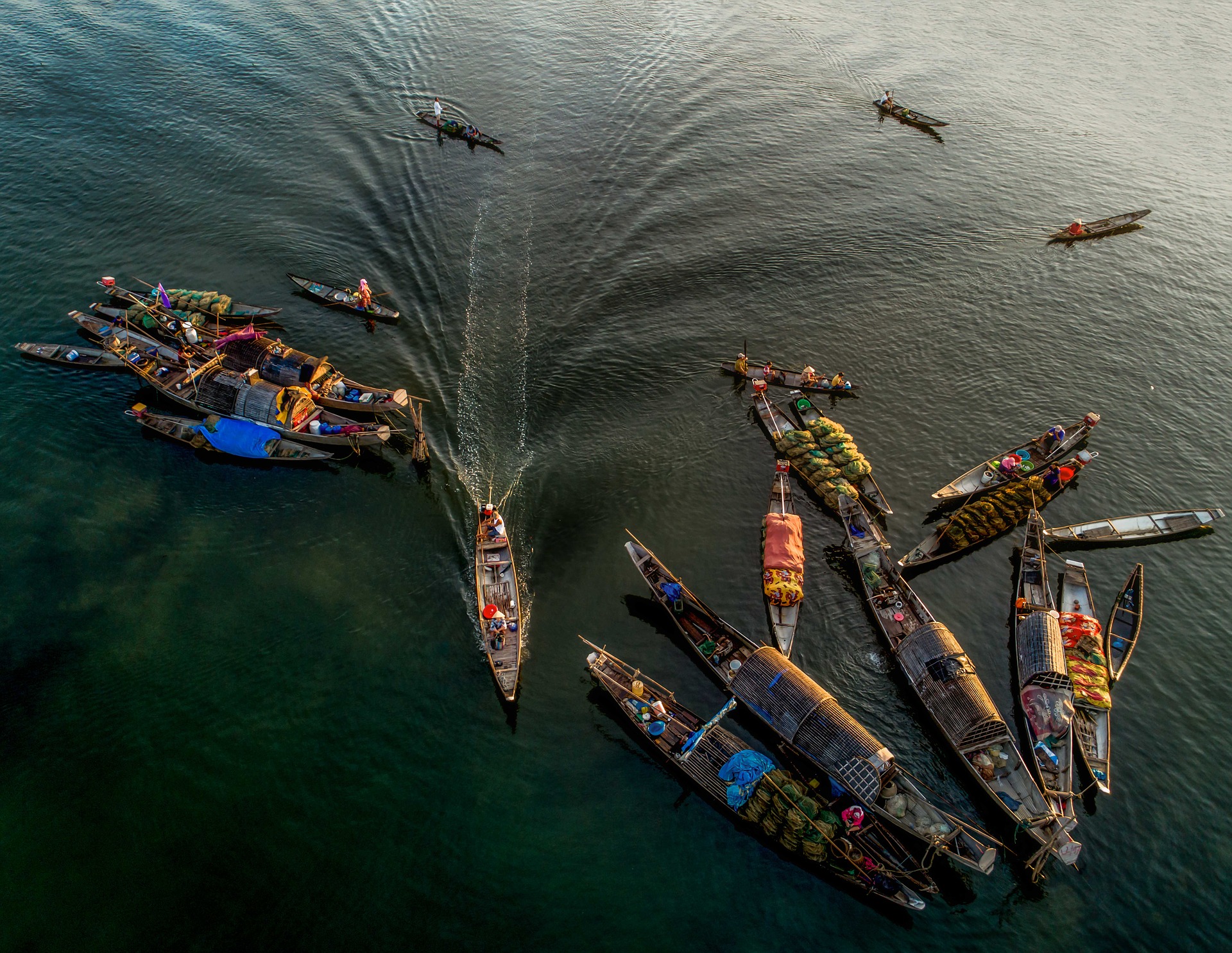Vinpearl Safari Phu Quoc Visitor Experience


The Cai Rang Floating Market is a vibrant and iconic landmark in the Mekong Delta region of Vietnam, offering visitors a unique glimpse into the country's rich cultural heritage and thriving river commerce. As one of the most famous floating markets in the world, Cai Rang has long been a hub of activity, where local farmers, merchants, and traders gather to buy, sell, and exchange a wide variety of goods.

The Cai Rang Floating Market is located in the city of Can Tho, which is situated in the heart of the Mekong Delta region in southwestern Vietnam. The market can be found along the banks of the Hau River, a major tributary of the Mekong River, about 6 kilometers (3.7 miles) from the center of Can Tho.
The Cai Rang Floating Market is situated in a strategic location, taking advantage of the region's extensive network of waterways and canals. The market's position along the Hau River allows for easy access by boat, making it a convenient destination for both local and visiting buyers and sellers.
The Cai Rang Floating Market is nestled amidst a lush and verdant landscape, with dense mangrove forests, lush orchards, and small villages dotting the riverbanks. The bustling activity of the market is complemented by the serene and picturesque natural setting, creating a unique and captivating atmosphere.
The Cai Rang Floating Market is closely connected to other nearby markets and trading hubs, such as the Cai Be Floating Market, which is located about 50 kilometers (31 miles) away. This interconnectedness allows for the efficient movement of goods and the exchange of information among the various markets in the region.

The Cai Rang Floating Market has a long and storied history, dating back centuries to the days when the Mekong Delta region was a hub of agricultural production and river-based commerce.
The Cai Rang Floating Market emerged as a natural extension of the region's thriving river-based economy, with local farmers and merchants taking advantage of the extensive network of waterways to transport and trade their goods. Over time, the market grew in size and importance, becoming a vital part of the local economy and a cultural touchstone for the people of the Mekong Delta.
While the Cai Rang Floating Market has maintained much of its traditional character, it has also undergone significant changes and modernization over the years. The increasing prevalence of motorized boats, for example, has transformed the market's visual landscape, while the introduction of new technologies and infrastructure has helped to streamline and improve the efficiency of the trading process.
Despite these changes, the Cai Rang Floating Market remains a deeply important part of the local culture and heritage. The market is seen as a symbol of the region's rich history and traditions, and efforts have been made to preserve its unique character and to promote it as a major tourist attraction.

The Cai Rang Floating Market is a bustling hive of activity, with a wide range of goods and services on offer to both local and visiting buyers.
The primary activity at the Cai Rang Floating Market is the buying and selling of a wide variety of agricultural products, including fruits, vegetables, and other food items. Merchants and traders can be seen negotiating prices and exchanging goods, creating a lively and vibrant atmosphere.
| Product | Description |
|---|---|
| Tropical Fruits | A wide selection of tropical fruits, such as mangoes, pineapples, and dragonfruit, are available at the market. |
| Vegetables | A diverse array of fresh vegetables, including leafy greens, root vegetables, and herbs, are sold by local farmers. |
| Seafood | The market also offers a variety of fresh seafood, including fish, shrimp, and other crustaceans. |
| Prepared Foods | In addition to raw ingredients, the market also features a selection of prepared foods, such as traditional Vietnamese dishes and snacks. |
One of the most distinctive features of the Cai Rang Floating Market is the way in which the buying and selling of goods is conducted entirely from boats. Merchants and traders navigate their vessels along the river, offering their wares to potential buyers and engaging in lively negotiations.
In addition to the buying and selling of goods, the Cai Rang Floating Market also offers a range of auxiliary services and activities for visitors to enjoy.
While the Cai Rang Floating Market is one of the most well-known and iconic floating markets in Vietnam, it is not the only one. The Cai Be Floating Market, located in the nearby province of Tien Giang, is another popular destination for visitors to the Mekong Delta region.
Both the Cai Rang and Cai Be Floating Markets are large-scale markets that offer a wide range of goods and services. However, the Cai Rang Floating Market is generally considered to be larger in scale and to offer a more diverse selection of products.
| Characteristic | Cai Rang Floating Market | Cai Be Floating Market |
|---|---|---|
| Size | Larger, with a greater number of vendors and boats | Smaller, with a more limited number of vendors and boats |
| Product Selection | Wider range of goods, including a greater variety of fruits, vegetables, and other agricultural products | More focused on specific products, such as fruits and prepared foods |
| Visitor Engagement | Offers more opportunities for interactive experiences, such as cooking demonstrations and craft workshops | Focuses more on the buying and selling of goods, with fewer additional activities for visitors |
In addition to the differences in scale and scope, the Cai Rang and Cai Be Floating Markets also differ in their geographical and cultural contexts.
The Cai Rang Floating Market is renowned for the wide variety of products and goods that are available for purchase, with a particular focus on agricultural and food items.
The Cai Rang Floating Market is a hub for the sale of a diverse array of tropical fruits, including:
In addition to the tropical fruits, the Cai Rang Floating Market also offers a wide selection of fresh vegetables and herbs, including:
Alongside the raw agricultural products, the Cai Rang Floating Market is also known for its selection of prepared foods and traditional Vietnamese snacks, including:
The Cai Rang Floating Market has become a major tourist attraction, drawing visitors from around the world who are eager to experience the vibrant and unique river commerce of the Mekong Delta region.
One of the primary ways for visitors to engage with the Cai Rang Floating Market is through organized boat tours and cruises. These excursions typically involve a guided journey along the Hau River, allowing visitors to witness the bustling activity of the market and the surrounding landscape.
The CaiRang Floating Market is a visually stunning destination, with its colorful boats, vibrant produce, and picturesque natural surroundings providing ample opportunities for photography enthusiasts.
In addition to the buying and selling of goods, the Cai Rang Floating Market also offers visitors the chance to immerse themselves in the local cuisine and culinary traditions.
Beyond the commercial activities, the Cai Rang Floating Market also provides visitors with opportunities to learn about the rich cultural heritage and traditions of the Mekong Delta region.
The Cai Rang Floating Market is deeply rooted in the local culture and traditions of the Mekong Delta region, with its activities and practices reflecting the unique heritage of the area.
The boat-based nature of the Cai Rang Floating Market is a reflection of the region's long history of river-based commerce and waterborne livelihoods. The Mekong Delta's extensive network of waterways has long been the lifeblood of the local economy, with generations of people relying on the rivers and canals for transportation, trade, and sustenance.
The Cai Rang Floating Market is also closely linked to the traditional agricultural practices and foodways of the Mekong Delta region. The diverse array of fruits, vegetables, and other products available at the market reflect the region's rich natural bounty and the deep expertise of its farmers and producers.
In addition to the agricultural and culinary offerings, the Cai Rang Floating Market also features a vibrant array of artisanal crafts and handmade goods, reflecting the skilled artisanship of the local population.
Accessing the Cai Rang Floating Market can be a bit of an adventure, but there are a variety of transportation options available to visitors.
One of the most popular and authentic ways to reach the Cai Rang Floating Market is by boat. Visitors can arrange for boat transfers or guided tours that depart from various points along the Hau River or nearby towns.
For those who prefer not to travel by boat, there are also various land-based transportation options available to reach the Cai Rang Floating Market.
While the Cai Rang Floating Market is generally accessible to visitors, there are a few considerations to keep in mind, particularly for those with mobility challenges.
To make the most of your visit to the Cai Rang Floating Market, here are some helpful tips to keep in mind:
The Cai Rang Floating Market is a vibrant and colorful hub of activity that offers visitors a unique glimpse into the rich culture and traditions of the Mekong Delta region. From its boat-based commerce and traditional agricultural practices to its artisanal crafts and handmade goods, the market embodies the spirit of community, ingenuity, and resilience that defines the local population.
As one of the largest floating markets in Vietnam, Cai Rang is not just a place to buy and sell goods but also a living testament to the enduring legacy of the region's waterborne livelihoods. Its bustling atmosphere, diverse offerings, and warm hospitality make it a must-visit destination for travelers seeking an authentic and immersive experience in the heart of the Mekong Delta.
Whether you arrive by boat or land, take the time to explore the market's treasures, savor its flavors, and connect with its people. The sights, sounds, and scents of the Cai Rang Floating Market are sure to leave a lasting impression and create memories that will stay with you long after you've left its lively waters. Immerse yourself in the magic of this floating gem, and let the spirit of the Mekong Delta captivate your senses and soul.
Comments
Post a Comment